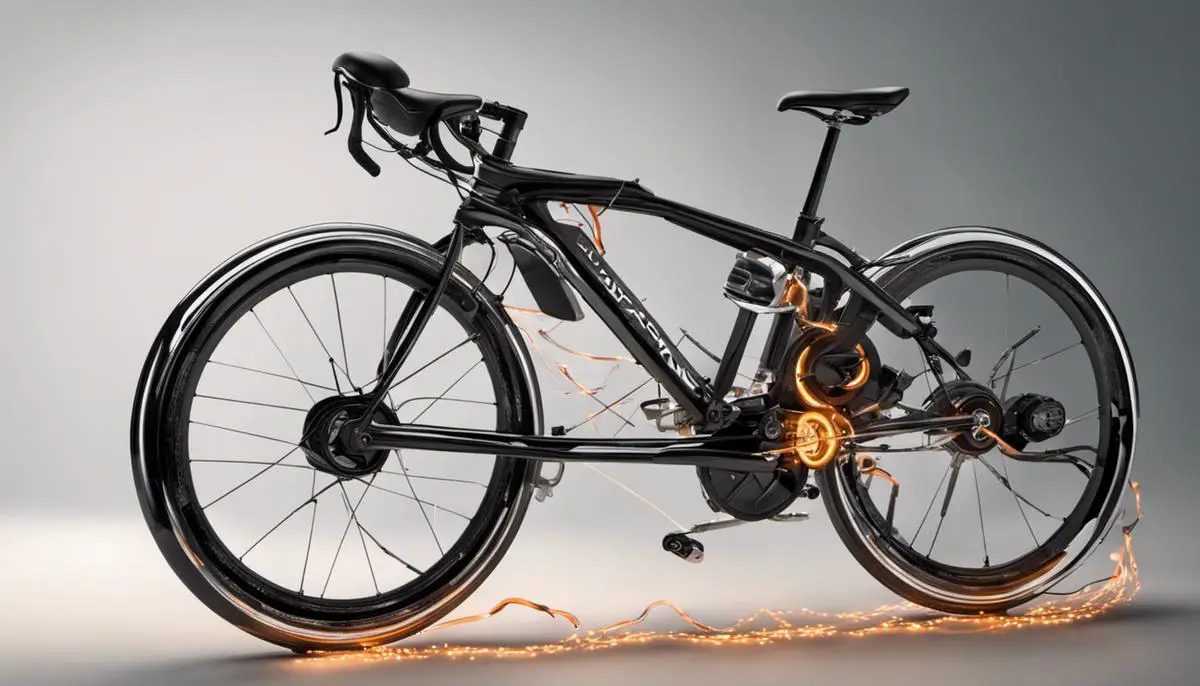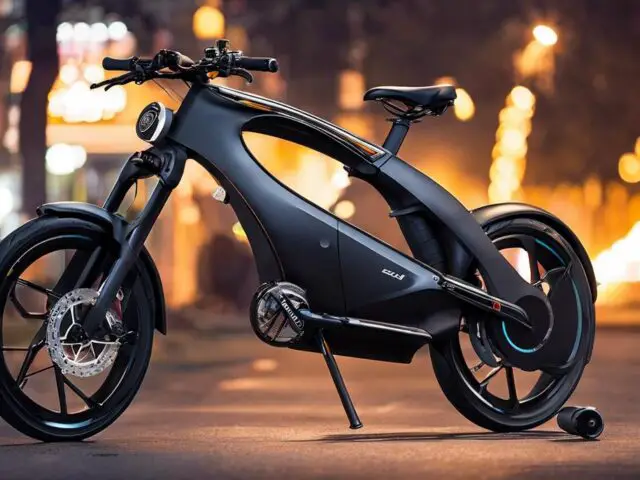Have you ever been cycling down a hill, enjoying the exhilarating feeling of picking up speed, only to have to abruptly brake and lose all that momentum? For e-bike riders, this can be a common frustration. The advent of e-bikes has revolutionized the transportation industry, carving out a niche that caters to those who favor environmentally friendly and efficient means of travel. Among the advancements resulting from the rise in e-bikes, Regenerative Braking is one feature that sticks out. This ingenious feature takes the kinetic energy generated during deceleration and reverts it into electric energy that recharges the e-bike’s battery. It’s a sophisticated technology that bridges the gap between science, utility, and sustainability.
Understanding the Concept of Regenerative Braking
Regenerative braking may sound like a complex term, but it’s actually a simple concept with profound implications for e-bike riders. Essentially, regenerative braking allows an e-bike to convert the energy generated during braking into usable power, effectively recycling that energy instead of wasting it.
To understand how regenerative braking works, it’s important to first grasp the basics of traditional braking systems. In a regular bicycle, when you apply the brakes, the kinetic energy of the moving bike is transformed into heat energy through friction. This dissipation of energy is what causes the bike to slow down and eventually come to a stop.
Regenerative braking takes this concept one step further. Instead of solely dissipating the energy as heat, regenerative braking systems on e-bikes have the ability to capture that energy and store it for later use. This is made possible by the integration of a special mechanism, typically a generator or electric motor, which is able to reverse its role and convert the rotational energy from the wheels into electrical energy.
The generated electrical energy is then fed back into the e-bike’s battery, replenishing its charge and extending the overall range of the bike. This innovative system allows riders to effectively recover and reuse the energy that would have been lost during braking. It’s like giving your e-bike a boost every time you brake, making your ride more efficient and sustainable.
The concept of regenerative braking is not limited to e-bikes. In fact, it is commonly used in hybrid and electric vehicles as well. However, e-bikes are uniquely positioned to benefit from regenerative braking due to their frequent stops and starts in urban environments. Think about how many times you brake during your daily commute, and imagine how much energy could be harnessed and reused.
By understanding the concept of regenerative braking, e-bike riders can appreciate the incredible potential it holds for transforming their riding experience. Not only does regenerative braking offer a more efficient and eco-friendly way to ride, but it also reduces the dependence on external charging sources, making e-bikes even more versatile and sustainable. With this knowledge, riders can confidently embrace regenerative braking as a game-changing technology that allows them to say goodbye to wasted momentum and hello to a greener, more sustainable ride.

How Regenerative Braking Works in E-Bikes
Regenerative braking in e-bikes is an innovative technology that allows riders to harness and reuse the energy generated during braking. This system works by capturing the energy that would normally be lost as heat and converting it into usable power, effectively recycling the energy and making the ride more efficient and sustainable.
To understand how regenerative braking works in e-bikes, it’s important to first grasp the basic principles behind traditional braking systems. When you apply the brakes on a regular bicycle, the kinetic energy of the moving bike is transformed into heat energy through friction. This dissipation of energy causes the bike to slow down and eventually come to a stop. However, regenerative braking takes this process one step further.
In e-bikes equipped with regenerative braking, a special mechanism, usually a generator or electric motor, is integrated into the braking system. When you apply the brakes, this mechanism is able to reverse its role and convert the rotational energy from the wheels into electrical energy. This electrical energy is then fed back into the e-bike’s battery, replenishing its charge and extending the overall range of the bike.
The process of regenerative braking occurs seamlessly, with the e-bike’s onboard system automatically engaging the regenerative braking feature whenever the brakes are applied. The rider experiences a smooth deceleration while simultaneously recharging the battery.
The beauty of regenerative braking in e-bikes is that it not only makes the ride more efficient, but it also reduces the reliance on external charging sources. Riders can now recover and reuse the energy that would have been lost during braking, making their e-bikes more versatile and sustainable.
Overall, regenerative braking is a game-changing technology for e-bike riders. It allows them to say goodbye to wasted momentum and hello to a greener, more sustainable ride. By effectively recycling the energy generated during braking, e-bike riders can enjoy a more efficient and eco-friendly riding experience. Regenerative braking is truly revolutionizing the way we ride, one pedal stroke at a time.

Photo by vaccinium on Unsplash
Benefits of Using Regenerative Braking in E-bikes
Regenerative braking is a game-changer for e-bike riders, offering a wide range of benefits that make the overall riding experience more enjoyable and sustainable. Let’s explore some of the key advantages of using regenerative braking in e-bikes.
Regenerative braking allows riders to recover and reuse the energy that would have been lost during braking. This means that every time you apply the brakes, instead of simply dissipating the energy as heat, the e-bike’s regenerative braking system captures and stores it for later use. By effectively recycling this energy, riders can extend the overall range of their e-bike and reduce their dependence on external charging sources. This not only saves time and money but also contributes to a more eco-friendly ride.
Another significant benefit of regenerative braking is its ability to improve overall efficiency. By harnessing and reusing the energy generated during braking, riders can experience a more seamless and uninterrupted ride. With regenerative braking, you no longer have to abruptly brake and lose all that momentum when going downhill. Instead, the e-bike’s braking system works in harmony with your pedaling, allowing for a smoother and more efficient transition between braking and acceleration. This makes your ride more enjoyable and helps you maintain a consistent speed throughout your journey.
Additionally, regenerative braking enhances the overall safety of e-bike riding. With the ability to slow down and recharge the battery while braking, riders have more control and can respond to sudden stops or obstacles with greater ease. This can be especially beneficial in urban environments where frequent stops and starts are common.
The benefits of using regenerative braking in e-bikes are clear. It offers riders the ability to recover and reuse the energy generated during braking, extending the overall range of their e-bike and reducing reliance on external charging sources. Regenerative braking also improves efficiency, allowing for a more seamless and enjoyable ride, while enhancing safety by providing better control and responsiveness. Embracing regenerative braking is not only a smart choice for e-bike riders but also a step towards a greener and more sustainable future. Say goodbye to wasted momentum and hello to a more efficient and eco-friendly ride with regenerative braking.
Here is a list of the benefits of regenerative braking in e-bikes:
- Extended range: Regenerative braking can extend the range of an e-bike by up to 20%, by recapturing some of the kinetic energy that is lost when braking and using it to recharge the battery.
- Improved battery life: Regenerative braking can also help to extend the lifespan of the e-bike battery by reducing the number of times it needs to be charged and discharged.
- Reduced wear and tear on brakes: Regenerative braking can help to reduce wear and tear on the e-bike brakes, as they are not used as often or as heavily.
- Safer riding: Regenerative braking can help to improve the safety of e-bike riders by providing additional stopping power.
- Reduced environmental impact: Regenerative braking can help to reduce the environmental impact of e-bikes by reducing the amount of energy that is consumed and the amount of emissions that are produced.
| Brand | Model | Price (USD) | Motor | Battery | Brake Type |
|---|---|---|---|---|---|
| Rad Power Bikes | RadCity 5 Plus Electric Commuter Bike | $1,499 | 750W hub motor | 48V 14Ah lithium-ion battery | Hydraulic disc brakes |
| Aventon | Level Electric Bike | $1,799 | 750W hub motor | 48V 14.5Ah lithium-ion battery | Hydraulic disc brakes |
| Specialized | Turbo Vado SL 5.0 Electric Hybrid Bike | $3,799 | 250W mid-drive motor | 375Wh lithium-ion battery | Hydraulic disc brakes |
| Trek | Dual Sport+ 4 Equipped Electric Hybrid Bike | $2,999 | 250W mid-drive motor | 500Wh lithium-ion battery | Hydraulic disc brakes |
| Giant | Explore E+ 2 Electric City Bike | $3,999 | 250W mid-drive motor | 500Wh lithium-ion battery | Hydraulic disc brakes |
In addition to these benefits, regenerative braking can also make e-bikes more fun and enjoyable to ride. The ability to recapture energy and use it to extend the range and lifespan of the battery can give riders more confidence to explore new places and ride for longer periods of time.

Practical Application and Performance of Regenerative Braking in Everyday Use
Regenerative braking in e-bikes is a practical and effective way to extend the range of the bike, improve battery life, reduce wear and tear on brakes, and improve safety. In everyday use, regenerative braking can be used to:
- Extend the range of the bike: Regenerative braking can capture some of the kinetic energy that is lost when braking and use it to recharge the battery. This can extend the range of the bike by up to 20%, depending on the riding conditions.
- Improve battery life: Regenerative braking can also help to improve the lifespan of the battery by reducing the number of times it needs to be charged and discharged. This is because the battery is not being used as heavily when regenerative braking is used.
- Reduce wear and tear on brakes: Regenerative braking can also help to reduce wear and tear on the brakes. This is because the brakes are not used as often or as heavily when regenerative braking is used.
- Improve safety: Regenerative braking can help to improve the safety of e-bike riders by providing additional stopping power. This is because regenerative braking can be used in conjunction with the traditional brakes to provide more stopping power.
In addition to these practical benefits, regenerative braking can also make e-bikes more fun and enjoyable to ride. The ability to recapture energy and use it to extend the range and lifespan of the battery can give riders more confidence to explore new places and ride for longer periods of time.
Here are some tips for using regenerative braking in everyday use:
- Use regenerative braking whenever possible. When you are braking, try to use regenerative braking whenever possible. This will help to extend the range of your bike, improve battery life, reduce wear and tear on brakes, and improve safety.
- Be aware of the limitations of regenerative braking. Regenerative braking is not as effective at high speeds as it is at low speeds. Additionally, regenerative braking may not be effective in all weather conditions, such as wet or icy conditions.
- Use the traditional brakes in conjunction with regenerative braking. Regenerative braking should be used in conjunction with the traditional brakes to provide the best possible stopping power.
Overall, regenerative braking is a valuable feature that can offer a number of benefits to e-bike riders. By following these tips, you can get the most out of regenerative braking in everyday use.

Limitations of Regenerative Braking in E-bikes
While regenerative braking is undoubtedly a game-changing technology for e-bike riders, it is essential to consider its limitations as well. Although regenerative braking offers numerous benefits, it is not without its drawbacks.
One of the primary limitations of regenerative braking is its efficiency. While regenerative braking systems are designed to capture and convert energy during braking, they are not 100% efficient. Some energy will still be lost in the conversion process, meaning that not all of the energy generated during braking can be effectively recovered and reused. This can result in a slight decrease in overall efficiency compared to traditional braking systems.
Additionally, regenerative braking systems require a certain amount of speed and force to effectively generate and capture energy. This means that at lower speeds or when applying the brakes gently, the regenerative braking system may not be as effective in recovering and storing energy. Riders may need to rely more on traditional friction braking in these situations, which does not offer the same energy-saving benefits.
Furthermore, regenerative braking can add additional weight and complexity to an e-bike. The integration of a generator or electric motor can increase the overall weight of the bike, which may be a concern for riders looking for a lightweight and agile e-bike. Additionally, the presence of a regenerative braking system adds complexity to the bike’s design and may require additional maintenance and repair in the long run.
Lastly, regenerative braking is not a substitute for responsible and safe riding habits. While regenerative braking systems can provide additional control and responsiveness, riders should not solely rely on them to navigate challenging terrain or emergency situations. It is still important to have proper braking techniques and be aware of your surroundings while riding an e-bike.
While regenerative braking offers numerous benefits for e-bike riders, it is crucial to consider its limitations as well. These limitations include slightly reduced efficiency compared to traditional braking systems, decreased effectiveness at lower speeds or gentler braking, potential weight and complexity additions to the bike, and the need for responsible riding habits. By understanding these limitations, e-bike riders can make informed decisions and fully harness the potential of regenerative braking in their rides.
Helpful Links
For all your RC Questions, Click HERE
If you are interested in RC cars and trucks, RC World has you covered.
For RC boats and watercraft, check these articles out.
For all your RC Airborne endeavors, we have everything you need.
How Do RC Boats Work?
If you’re considering purchasing an RC boat, you may be wondering: how do RC boats work? Well, this article will discuss the parts of RC boats, from the…
E-Skateboards vs Regular: UX Showdown
The evolution of skateboarding from kick-pushing along sun-drenched boulevards to harnessing the whir of electric motors represents more than just a shift in technology—it marks a significant divide…
Top Benefits of Foldable E-Bikes
The swell of urbanization and the relentless quest for convenience have paved the way for innovations in personal transportation that must be both practical and environmentally conscious. Foldable…
10 Tips for Better Electric Skateboard User Experience
Stepping onto the world of electric skateboarding can be both thrilling and daunting. The power to glide down the streets, effortlessly navigating through people, and exploring new routes…
Boost Your Fitness: E-Bike Interval Training Tips
Embracing e-Bike interval training could be the ultimate game-changer in your quest to skyrocket your fitness levels. Before diving headfirst into it, it’s imperative to grasp the basics…
Essential Safety Gear for Electric Skateboarding
Electric skateboarding has grown tremendously in popularity, surfacing as an exhilarating sport as well as a handy transportation method. It offers an alternative to traditional skateboarding, and is…
How Do E-Bikes Work? A Closer Look
Electric bikes, also known as e-bikes, have gained popularity in recent years due to their convenience and eco-friendly nature. But how do these bikes actually work? In this…
Essential Gear for Electric Skateboarding
Electric skateboarding is not just about the thrill and speed; it’s also about making sure you can enjoy every ride safely. This article will explore the essential gear…
Finding Perfect Wheel Size for Electric Skateboarding
Choosing the right wheel size for your electric skateboard can significantly enhance your riding experience. Navigating the world of skateboard wheels can be daunting with such a variety…










